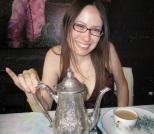
I have recently been struck by the preponderance of family dysfunction in Western fairy tales and myths. It seems that everywhere I turn, I find another evil mother or unkind sibling. Here are only a sampling of stories involving family strife and betrayal:
- In Cinderella, she has an unkind stepmother (who I read was the biological mother in some older versions), an absent father, and cruel step/half/full sisters who compete with her for one man.
- In Thousand Furs/Donkeyskin, the father either tries to or succeeds at raping his daughter the princess.
- In The White Cat, we have three brothers competing for their father’s throne.
- In Blockhead Hans, we have older brothers being cruel to their youngest “simple” brother.
- In Toads and Diamonds, we have an evil “step”mother and sister conspiring against our heroine.
- In Snow White, we have the evil, jealous stepmother who wants her stepdaughter to be killed. And what about the father? He’s apparently alive and just completely neglectful of his daughter.
- In Hansel and Gretel, we have the evil wife who wants to get rid of an excess of children.
- In Beauty and the Beast, we have a father willing to sacrifice his daughter for himself.
- In the legends of King Arthur, we have the seduction of King Arthur by his half-sister Morgan, and his troubled relationship with his son Mordred.
- King Lear has its root in British mythology, and shows the unhappy relationship between a king and his three daughters (and jockeying between the three daughters for position, including use of armed force).
- In Rumpelstiltskin, we have a father willing to sacrifice his daughter to save himself because he lied, and the daughter in her turn carrying on the family tradition by being willing to sacrifice her future child for her own safety.
- In Rapunzel (or now Disney’s version Tangled), we have the overprotective and narcissistic “mother”, exemplified by the wicked witch who pretends to be a blood relation.
- Don’t even get me started on those crazy Greek gods and goddesses!

I find this particularly fascinating because I’m used to thinking of family dysfunction as a modern phenomenon that only began to be spoken of in the last few decades, but of course there have been dysfunctional families since the dawn of time. Not only that, but it seems to have been a subject of much interest and anxiety in times past to be featured so prominently in the surviving stories.
This consciousness in fairy tales runs counter to the zeitgeist of the 1950s, which seems to be personified by the TV series title “Father Knows Best” and idealizes maintaining an image as the “perfect family”. No, in fairy tales, the downtrodden member of the family is usually the protagonist of the story, and these heroes and heroines are often shown having adventures and using adversity to help them transform so that they are able to escape their tormenting relations. In other words, they often win. The evil family members in question often meet horrible and gruesome fates, like the step sisters in Cinderella who have their eyes pecked out when attending Cinderella’s wedding, or Snow White’s evil stepmother who is forced to wear iron shoes and dance until she drops dead. Other times our protagonists merely leave their family members far behind as they begin their new lives.
Are these tales truly discussing dysfunctional families or are they merely providing enough hardship and conflict (often in the form of evil family members) to force the protagonists into growing up and coming into their own? Whatever the answer, it’s hard for me to read them now without noticing the implicit moral of distrust of family and reliance on self — maybe with a little help from a magical item or a fairy godmother along the way.
